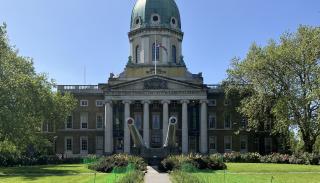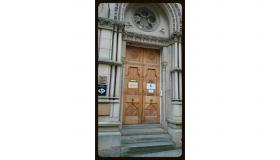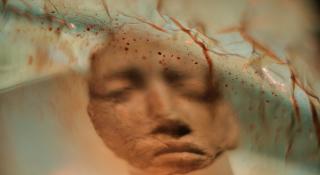
Breadcrumbs navigation
Peace on display: Examining peace knowledge(s) in UK museums
In this article, Dr Lydia Cole discusses how her project sought to explore the ways that peace is represented in the United Kingdom, focusing on peace narratives in two key museum sites: the Imperial War Museum in London and The Peace Museum in Bradford.
While research on museums in International Studies has often focused on the commemoration of war, conflict, and political violence, there has been a less sustained focus on the curating of and for peace. This project aimed to fill this gap by examining how peace is represented, displayed and known in UK institutions. Lydia was the recipient of a BISA Early Career Small Research Grant (ECSRG).
‘[T]he media that shape us individually and collectively rarely get us wrestling with peace as a concept; as a result, we struggle to visualise or grasp it, and so tell fewer stories about it, and so the cycle goes on.’ - Consiglio, König and Oberholzter, Visualising Peace: A Virtual Museum.
The project developed from a curiosity about how peace is visualised in the United Kingdom. The quote that begins this piece notes the relative absence of peace representations in the public domain. One key space where such representations have been present is in the museum. This prompted an examination of how, where and why peace is curated in this context. The project has developed at an exciting moment: The Peace Museum is due to reopen its doors to the public at its new home in Salts Mill, Saltaire in August 2024 and there are also ongoing discussions about the development of a Museum of the Troubles and Peace in Northern Ireland. At the same time, this is a challenging time for peace curating. War is not only at the forefront of the global agenda, but there are difficult questions being asked about the UK’s involvement and complicity in global violence. Peace curators bear responsibility for curating this difficult knowledge. Yet, they often operate within an institutional landscape that shapes how they are able to represent it.
As part of this grant, I explored how peace has been curated in two specific sites: Imperial War Museum and The Peace Museum. Research at the Imperial War Museum focused on People Power: Fighting for Peace, which traced the history of Britain’s peace movement over the past one-hundred years. People Power was a temporary exhibition, part of the museum’s broader curatorial aim to display diverse perspectives on war and conflict. Held in 2017, the exhibition formed a key part of the museum’s centenary celebrations. In this sense, it was a significant exhibition for the Imperial War Museum. What interested me most were the afterlives of this exhibition in the museum’s displays and collections. I wanted to know what impact, if any, putting peace on display had in this context. The grant enabled me to conduct archival work in the museum collections, where I was able to access photographs, sound recordings, and objects featured in the exhibition. I also conducted fieldwork at the museum itself, paying attention to the presence and absence of peace knowledge in the current displays.

The Peace Museum centres the stories of peace movements and peacemakers as part of its central curatorial mission. As such, research at this site required an exploration of the collections and the ongoing conversations about their curation and re-curation. Prior to the BISA grant, I had the opportunity to attend Defining Peace, a temporary exhibition of the museums collections in Kala Sangam in Bradford that posed the question: what is peace? Responses to the exhibition formed a key part of the museum’s process of re-curation. The BISA grant allowed me develop my insights into this context of curating through archival work at the new premises of The Peace Museum in January 2024. During this time, I was also able to speak with curators and other museum staff about their plans for the Summer opening.
My research findings build on a rich critical security scholarship interested in the curation of war and conflict, supplementing existing scholarship through a focus on representations of peace. It is worth pointing out, in contrast to Richard Jackson’s findings about a disciplinary silence surrounding peace knowledges, such ideas are present and actively curated in the space of the museum. Both sites enhance their displays of peace narratives through creative display techniques. This includes the use of evocative soundscapes, colour and symbols, and interactive displays. My research shows that museums are spaces that not only trace histories of peace, but also seek to evoke it for audiences, working to promote peace imaginaries. However, the research also reveals that peace curating operates within institutional, structural and economic limits. In this sense, it is important to attend to political economy of museums as a supplement to discussions on its visions of peace. More broadly then, this project has helped to gain insight into the landscape of peace curating in the United Kingdom; its institutional context, collections and displays, and its spaces of collaboration.
I am grateful for BISA’s support for this project. The grant enabled in-dept research into the two sites of focus and created an opportunity to engage with interdisciplinary researchers who use creative methods in their research. Looking forward, I am developing the conceptual and empirical insights of the project through publication. A draft on peace curating at the Imperial War Museum was presented at BISA’s Annual Conference in 2024. As noted, there are questions that still remain about the relationship between peace imaginaries and the political economy of (global) museums, and I hope to examine these questions through continuing work in the UK context and beyond.
Main image by Dr Lydia Cole.
Image of the entrance of the Peace Museum by The Peace Museum licensed under the Creative Commons Attribution-Share Alike 4.0 International license.


